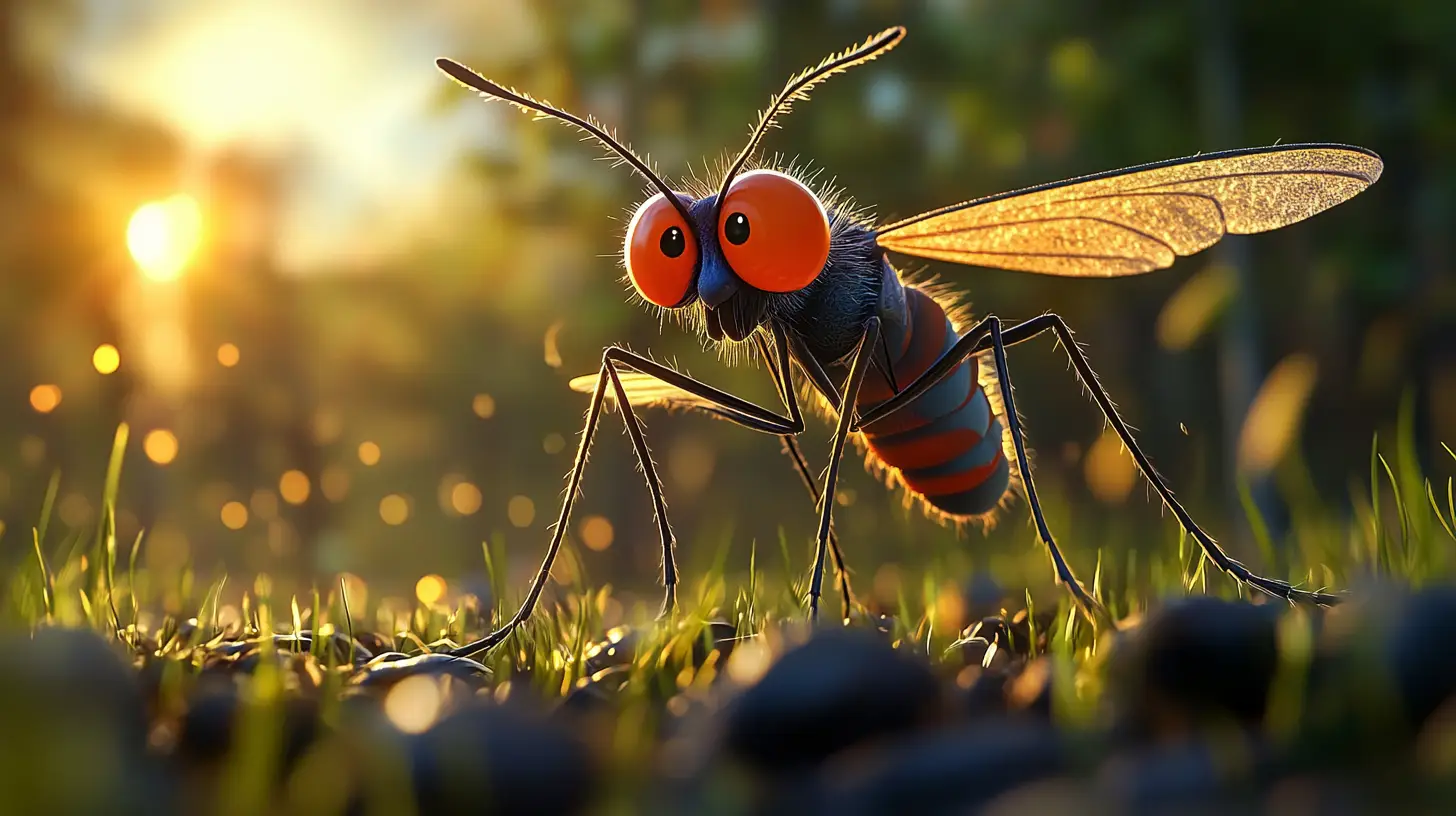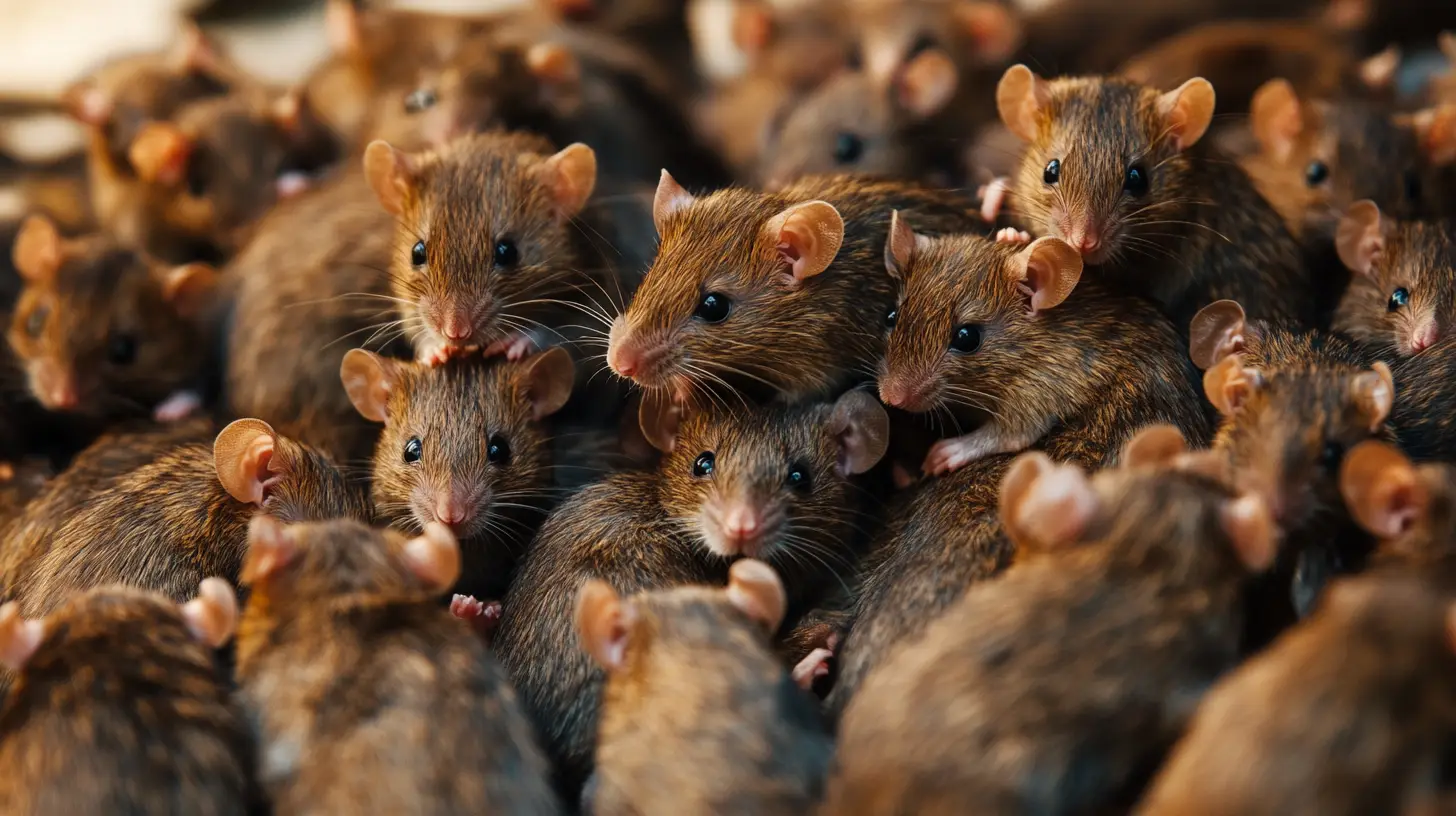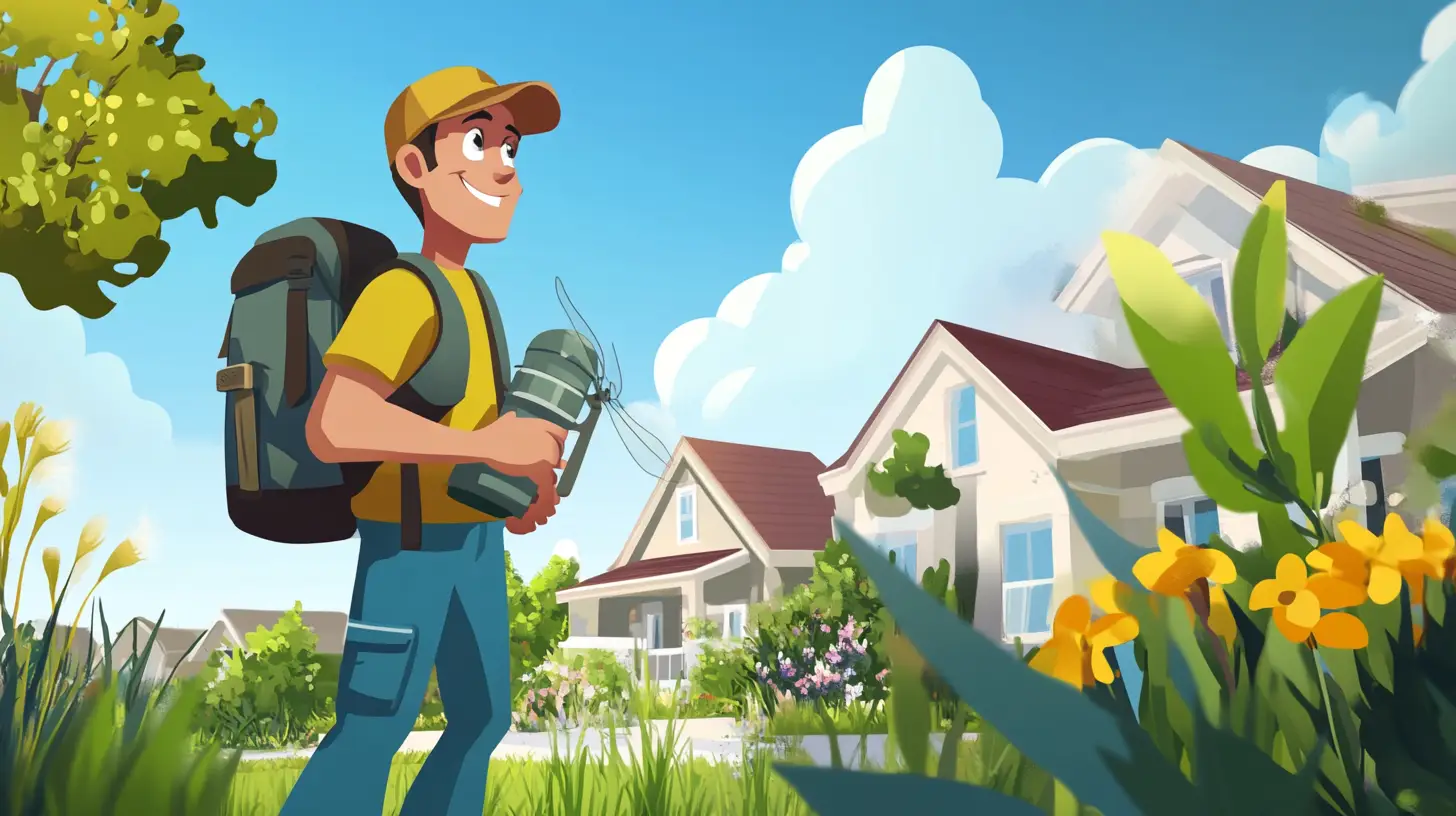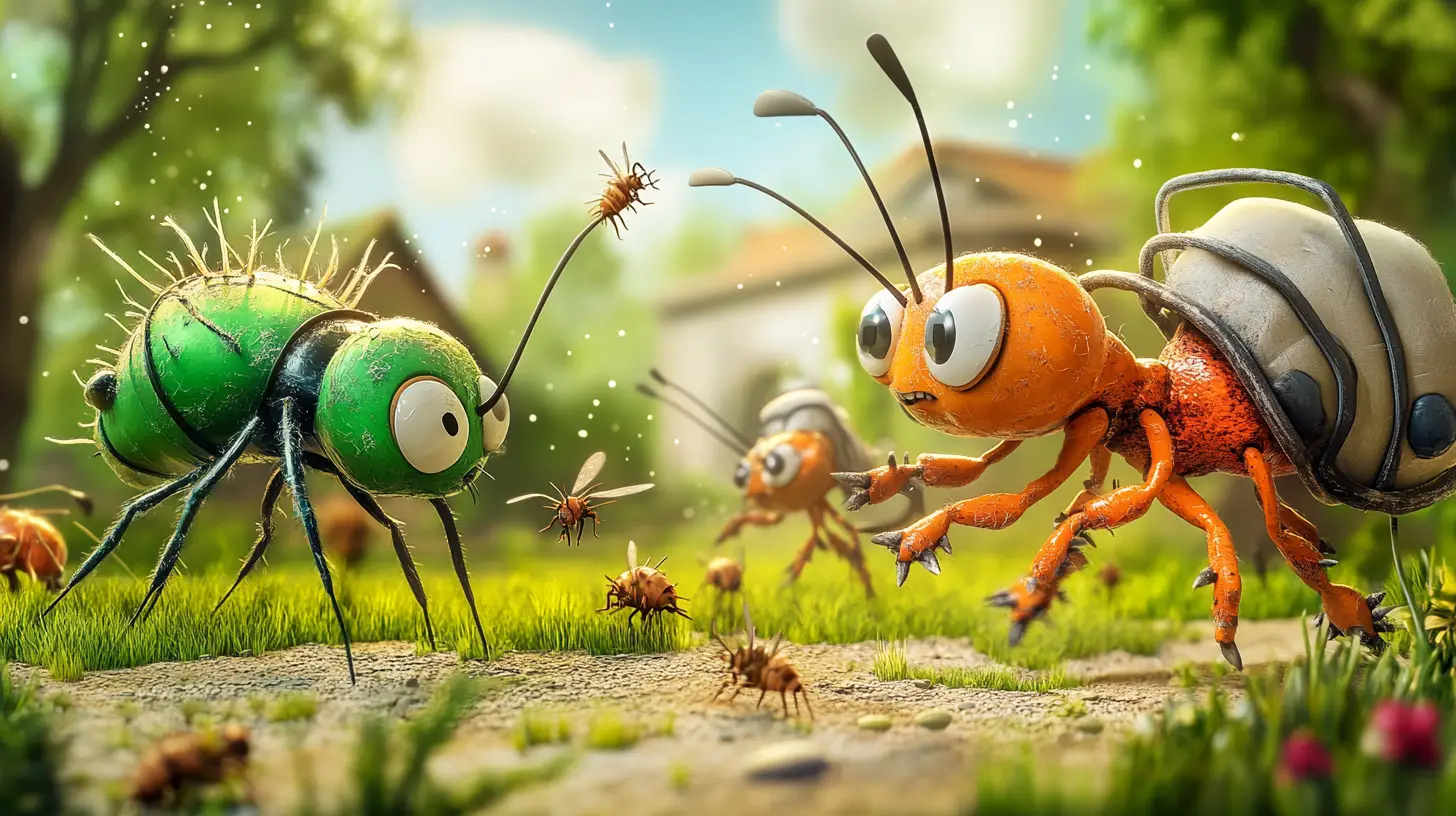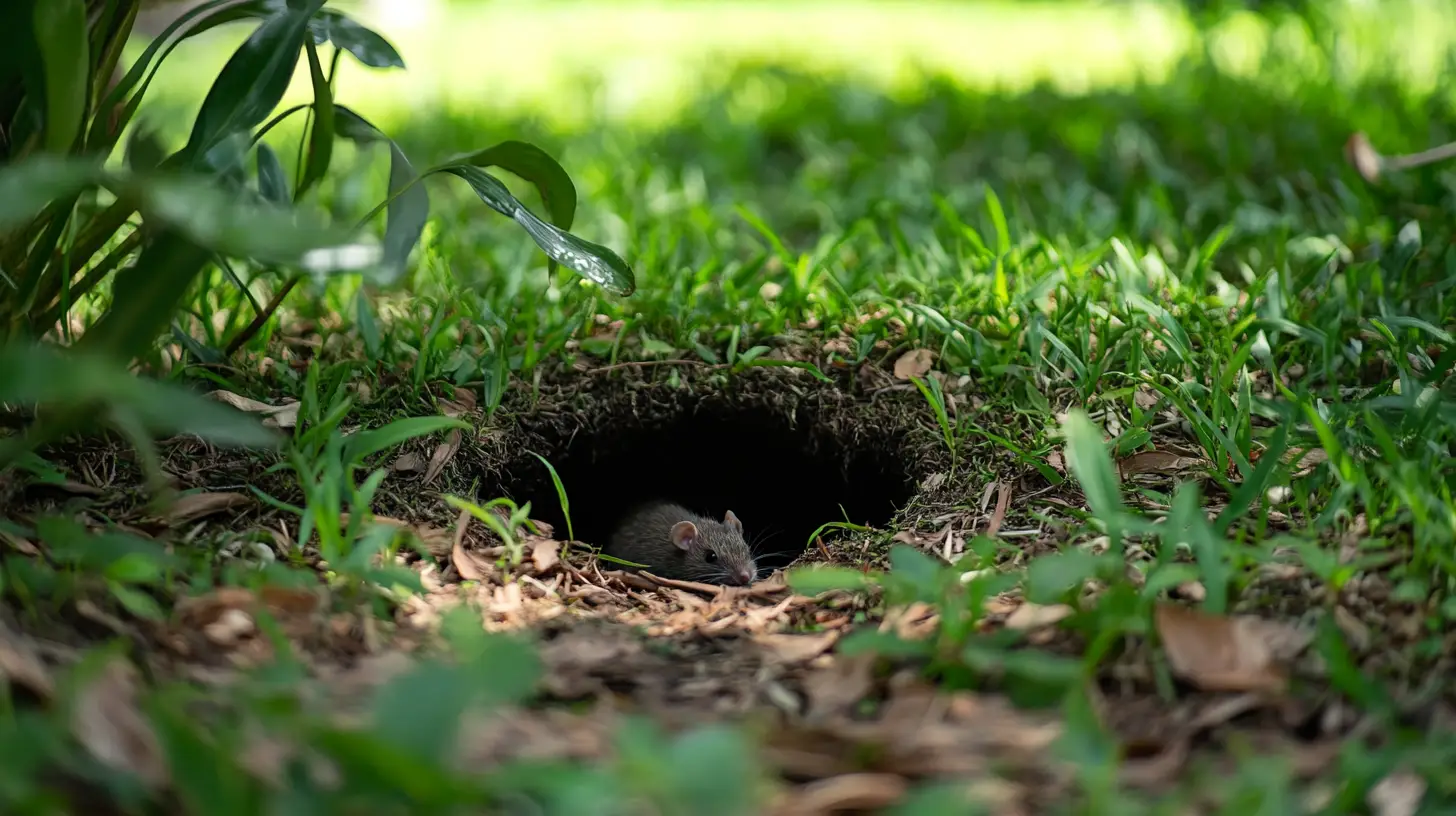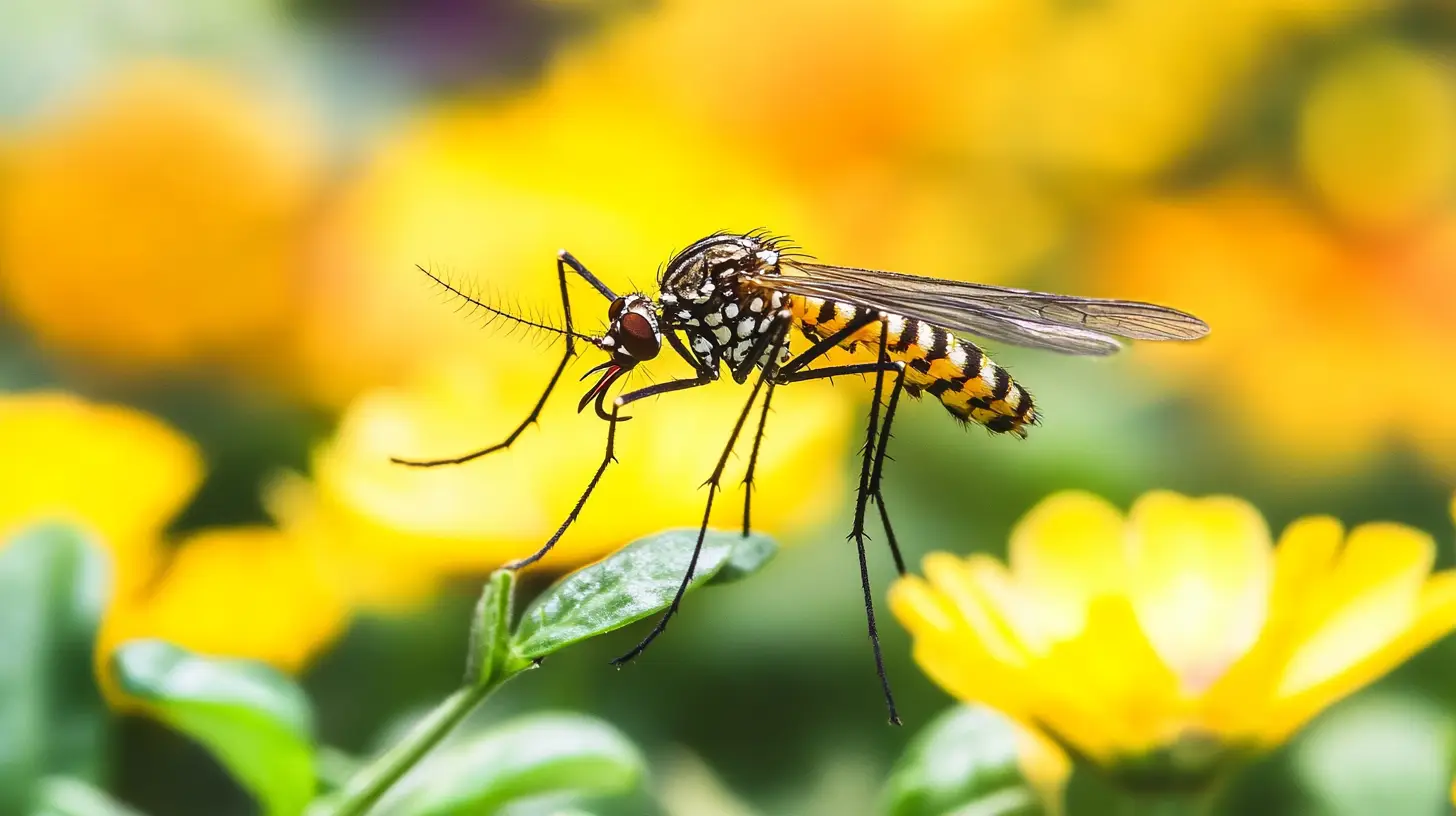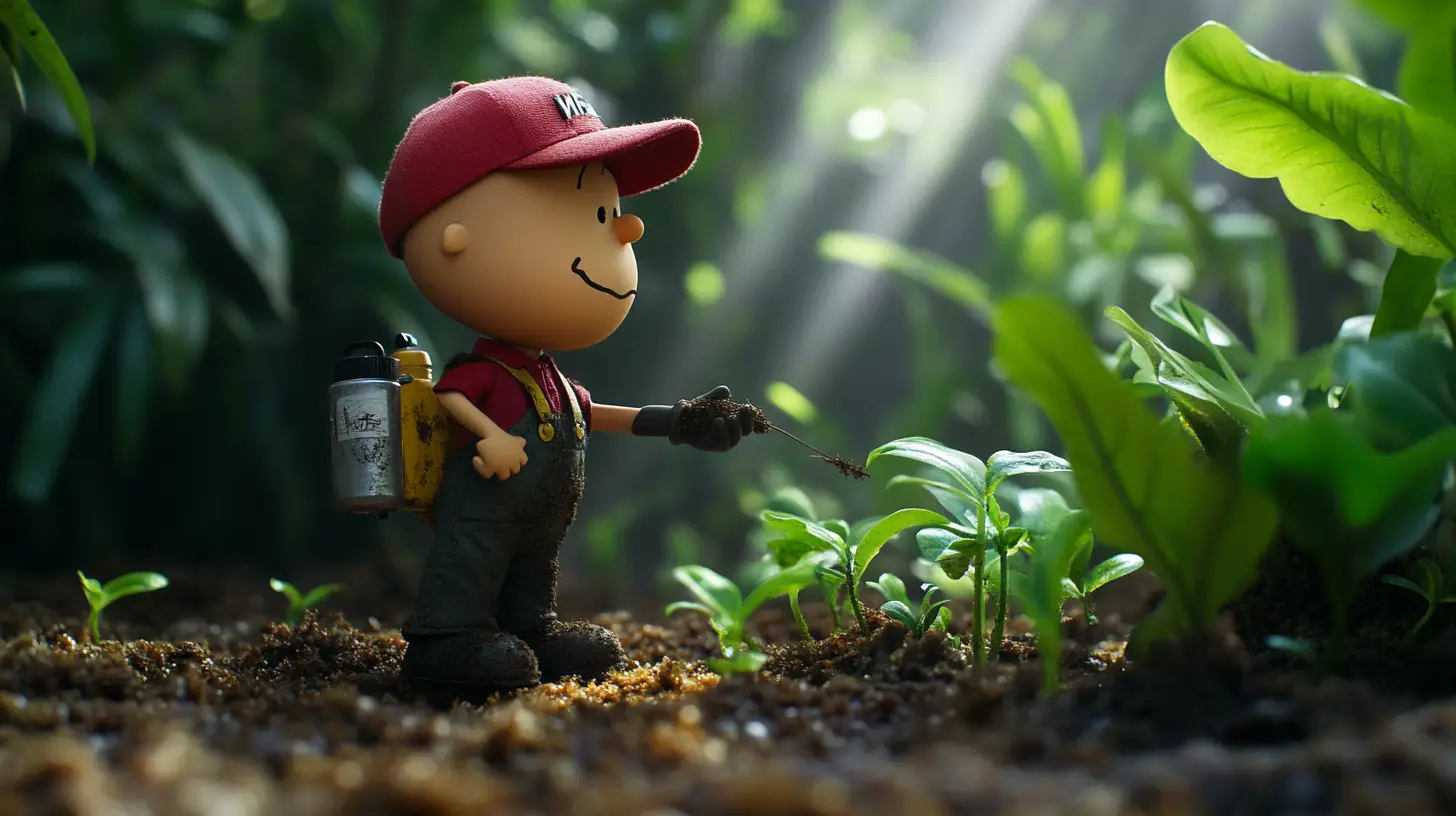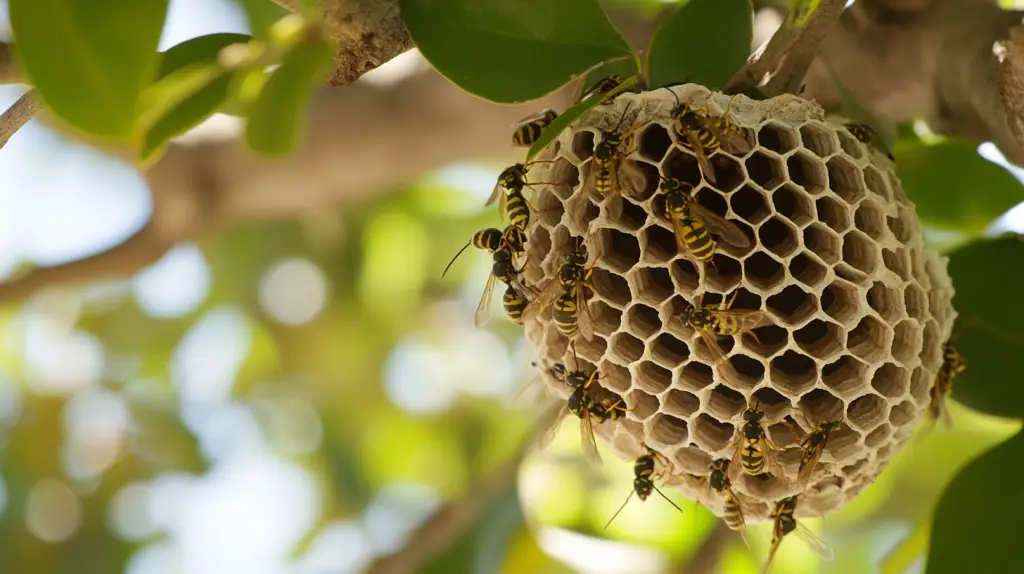
Table of Contents
Discovering a wasp nest in your Lakewood Ranch backyard can be unsettling, instantly turning your tranquil outdoor retreat into a place you’d rather avoid. The size of wasp nests can vary greatly depending on the species and environmental conditions. A nest can house several hundred to thousands of individuals, especially in species like the yellowjacket. Large nests can have an elaborate network of cells and tunnels.
Did you know that wasp nests are crafted from a material similar to paper? These diligent insects chew wood fibers and mix them with their saliva, creating a lightweight, papery pulp that forms the walls of their home. Inside these nests, the intricate arrangement of hexagonal cells mirrors the efficient architecture of honeybee hives. It’s a perfect blend of natural engineering, designed to nurture their eggs and young while maximizing space.
Whether it’s a small nest or a more established colony, we’re here to help you get rid of wasp nest. Ready to make your outdoor space yours again? Let’s walk you through how to do it safely and effectively.
Key Takeaways
- Know Your Allergic Status: Before attempting to remove a wasp nest, confirm whether you’re allergic to wasp stings to prevent severe reactions, including anaphylaxis.
- Wear Protective Clothing: Always wear long-sleeved shirts, pants, gloves, and a hat while dealing with a wasp nest to minimize sting risks.
- Identify the Nest’s Location: Determine the exact location and type of the wasp nest, as different species and nest locations may require different removal methods.
- Timing of Removal: Remove the nest either early in the morning or at night when wasps are less active to reduce the chances of getting stung.
- Responding to Stings: Know how to handle wasp stings, including initial steps like removing the stinger and applying cold packs to manage pain and swelling.
- Consult Professionals: For large nests or nests in difficult-to-reach areas, it’s best to contact professional exterminators to ensure safe and effective removal.
Most Common Wasps in Lakewood Ranch, FL
If you’ve ever spent time outdoors in Lakewood Ranch, you’ve probably spotted a wasp or two buzzing about. Whether it’s enjoying a backyard barbecue or strolling through one of our beautiful local parks, these winged residents are part of the scenery. But not all wasps are the same, and knowing the difference can help you stay safe and keep your home wasp-free.
One of the most familiar faces—or rather, wings—you’ll encounter is the Paper Wasp. These wasps are known for their umbrella-shaped nests made from a papery material, often found hanging under eaves or tucked into the corners of porches. While they may look intimidating, paper wasps are generally uninterested in people unless their nests are threatened. Their role in controlling pest insect populations is one reason why it’s good to give them their space.
Another frequent visitor in Lakewood Ranch is the Yellowjacket. Unlike the relatively calm paper wasps, yellowjackets are the ones to watch out for. These wasps are notorious for their bold, sometimes aggressive behavior, especially in late summer when food sources grow scarce. They often build hidden nests underground or in wall cavities, making accidental encounters more common. If you notice yellowjackets around your property, it’s wise to steer clear and call a pest control professional if you suspect a nest nearby.
There’s also the more solitary yet intriguing Mud Dauber. Unlike the others, mud daubers prefer working alone. You may see them constructing their nests, which look like little tubes made of mud, under overhangs or on outdoor walls. They rarely sting, and their main focus is hunting spiders to feed their young, which makes them an interesting and relatively harmless neighbor in the wasp world.
For homeowners in Lakewood Ranch, understanding the habits of these wasps can make all the difference in managing them safely and effectively. Wasps are part of our local ecosystem, helping to control other pests—but when they get too close for comfort, it’s good to know how to respond.
If you’re dealing with wasps around your home, or just want to learn more about keeping your property wasp-free, our local pest control experts are always here to help.
Understanding Wasp Nests in Lakewood Ranch, FL
If you’re a resident of Lakewood Ranch, you know that spending time outdoors is one of the joys of living here. However, along with the pleasant Florida sunshine, you might find a wasp nest or two on your property. While wasps are an important part of our environment, knowing how to identify and handle their nests can make your home safer and more enjoyable.
Once you find the nest, ensure you’ve correctly identified it. Not all wasp nests look alike. Paper wasps build umbrella-shaped nests that hang from a single stalk, whereas yellowjackets often construct large enclosed nests with multiple layers. Some wasp species, like mud daubers, build nests from mud instead of the typical paper pulp.
Wasp nests vary in size from as small as a golf ball to much larger structures. They’re typically made of a papery substance created by the wasps chewing wood fibers. Compare this with bee or bumblebee nests, which often have a different appearance and material. If you’re in Lakewood Ranch, noting the local wasp species can help in correct identification.
Wasp nests often have multiple layers of cells arranged vertically. This layered construction allows the nest to grow larger and provide more space for brood rearing as the colony expands throughout the season. Not all wasp nests are found hanging from trees or under eaves. Species like yellowjackets frequently build their nests underground. These nests can be in abandoned rodent burrows or other cavities, making them difficult to spot until a person or pet disturbs them accidentally.
Identifying Common Wasp Nests in Lakewood Ranch, FL
The type of wasp often determines the nest you’ll find. For instance, Paper Wasps create nests that look like a cluster of hexagonal cells, almost like an open honeycomb. They are usually suspended under roof eaves or tucked away in sheltered spots like light fixtures or porch corners. Paper wasp nests are typically small and relatively exposed, making them easier to spot.
On the other hand, Yellowjackets prefer nesting in hidden areas. Their nests are often underground or in wall voids, which can make them trickier to locate until activity increases. Yellowjackets are known for their aggressive nature, especially if their nest is disturbed, so it’s crucial to stay cautious if you spot them coming and going from a particular area on your property.
Mud Daubers, the more solitary wasp, construct their nests out of mud in the form of small, cylindrical tubes. These nests are often found under overhangs or on outdoor walls. Mud daubers are not as aggressive as other types of wasps and tend to keep to themselves, which is why their nests are typically less concerning.
Determining the type of wasps you’ll be dealing with is another crucial step in this process. Different species, such as yellowjackets or paper wasps, often require varying approaches to wasp removal. This knowledge aids in choosing the right method and enhances effectiveness.
If you’ve noticed wasp activity around your Lakewood Ranch property and aren’t sure what to do, our team at Waves Pest Control is always ready to help you with an effective and safe plan.
Ensure You Aren’t Allergic
Knowing if you’re allergic to wasp stings is essential before attempting to remove a nest. Allergies can lead to severe reactions, including anaphylaxis, which can be life-threatening if not treated promptly. A simple way to check is by consulting your healthcare provider.
Wasp stings can cause mild to severe reactions, with symptoms ranging from local swelling and redness to systemic reactions like difficulty breathing. Given that Lakewood Ranch’s warm climate supports a high wasp population, understanding your allergic status becomes even more crucial. If your allergic reactions are unknown or you have a history of allergies, get rid of wasp nests with extreme caution.
Wear protective clothing like long-sleeved shirts, pants, gloves, a hat, and a facemask or a beekeeping suit to minimize exposure to stings. Also, have an emergency plan in place, including access to an EpiPen if needed. Wear protective gear even if you’ve never had an allergic reaction, as repeated stings can increase sensitivity over time.
Knowing your allergic status is indispensable for safely get rid of wasp nests. Prioritize safety by ensuring you’re not allergic before starting the removal process.
In Case of a Wasp Sting
Even careful planning can lead to unexpected wasp stings. Knowing how to respond quickly is essential, especially if you’re in Lakewood Ranch where wasps can be common. If stung, immediately leave the area to avoid additional stings.
Initial Steps
Remove the stinger, if visible, using a scraping motion with a blunt object like a credit card. Avoid squeezing the site to minimize venom spread. Clean the affected area gently with soap and water to prevent infection.
Managing Pain and Swelling
Use a cold pack or ice wrapped in a cloth to reduce pain and swelling. Apply it for 10-15 minutes. Over-the-counter pain relievers like ibuprofen or acetaminophen can help alleviate discomfort. Hydrocortisone cream can reduce itching and swelling.
Monitoring for Allergic Reactions
Keep a close eye on symptoms, especially within the first hour. Look for signs of a severe allergic reaction, like swelling of the face, lips, or throat, difficulty breathing, or dizziness. If any of these symptoms appear, seek emergency medical help immediately. Having an EpiPen on hand is advisable if you are aware of your allergy.
Natural Remedies
Applying a paste of baking soda and water or using calamine lotion can soothe the sting. Aloe vera gel provides a cooling effect and helps with healing.
Expert Advice
Entomologists emphasize that while wasps play a crucial role in the network by controlling pest populations, their stings can pose serious health risks. If you find frequent wasp activity around your property, consult a pest control service.
Locate the Nest
Identifying a wasp nest is the first step in safely managing your wasp problem. Wasp nests can be found in a variety of locations. They prefer sheltered areas such as eaves, attics, tree branches, or even inside walls. They typically choose spots that provide some protection from the elements and predators.
A wasp nest usually starts with a single queen in the spring. She finds a suitable site, starts building the first few cells, and raises the first batch of worker wasps by herself. Once they mature, the workers take over nest-building and foraging, allowing the queen to focus solely on egg-laying. Unlike beehives, which can last for several years, most wasp nests are annual. The colony dies off in the fall, and only fertilized queens survive by hibernating through the winter. They emerge in the spring to start new nests rather than reusing old ones.
Wasps use pheromones as a defense mechanism for their nests. If a nest is threatened, the disturbed wasp releases an alarm pheromone that attracts other wasps from the nest to come and attack the intruder. This rapid chemical communication makes wasps formidable defenders of their nests. Wasps inside the nest communicate with each other using vibrations. When a wasp senses danger, it can release an alarm pheromone and vibrate its body, which alerts the other wasps to defend the nest.
Wear Protective Clothing
Wearing protective clothing minimizes the risk of being stung when you remove a wasp nest. Cover as much skin as possible to create a barrier between you and the wasps. Opt for long-sleeved shirts and long pants. Closed-toe shoes are essential to protect your feet. Thick, durable gloves shield your hands from potential stings. For your face and head, consider a hat and a veil or mask. A beekeeping suit provides extra protection when handling large or aggressive nests.
While this gear might seem excessive, entomologists stress its importance. Wasps can become aggressive when their nest is threatened. By being fully covered, you reduce entry points for these insects to sting. This safety precaution is vital not only to prevent discomfort but also to avoid possible allergic reactions.
Keep Children Away
Safety around a wasp nest is paramount, especially for children. Curious by nature, kids might unintentionally disturb the nest, increasing the risk of stings. Taking a few proactive steps can help keep them safe.
First, establish a no-play zone around the identified nest. Mark this area clearly, using cones or markers, and explain to your children its importance. Ensure they understand that wasps can feel threatened and become aggressive if their nest is disturbed.
Second, make time to educate your children. Briefly explain what wasps are, why their nest should be avoided, and what to do if they see increased wasp activity. Knowledge reduces curiosity, which in turn reduces risk.
Monitor play areas closely during the nest’s removal process. Even with protective measures in place, children can be unpredictable. Supervise outdoor activities more intently during this period. If a nest is found in a frequently visited area such as the backyard, consider relocating play to a different part of the yard or visiting local parks until the wasp nest is safely removed.
Get Rid of a Wasp Nest at Night
Removing a wasp nest is a delicate task. You’ll find night-time is the optimal period as wasps are less active and more contained within the nest. Wear protective clothing, including long-sleeved shirts, pants, gloves, and a hat to shield against possible stings.
Safety Precautions
Ensure you have the necessary protective gear to avoid stings. Wasps can be aggressive if provoked. Wearing thick gloves and long-sleeved clothing minimizes exposure to stings. Keep children and pets indoors during the process to prevent distractions and mitigate risk.
Best Time for Removal
Wasps are less active after dusk and before dawn. Their reduced activity makes it easier to approach the nest safely. If conditions meet this criterion, proceed with your removal methods.
Methods to Remove a Wasp Nest
Using Wasp Killer Spray
One effective method involves a commercial wasp killer spray. Available in most hardware stores, these sprays should be used from a safe distance. Target the nest’s opening to ensure wasps inside are coated. Saturate the nest thoroughly per the can’s instructions.
Using Dish Soap and Water
A more DIY approach employs dish soap mixed with water. Fill a spray bottle with water and add a few tablespoons of dish soap. Spraying this solution on the nest clogs wasps’ pores and wings, immobilizing them. Although simpler, it’s effective for smaller nests.
Consider Lakewood Ranch’s environment while performing this task. Wasps play a critical role in controlling other insect populations and pollinating plants. If the nest is in a less intrusive spot, leaving it till winter can be an eco-friendly choice. Wasps naturally die out after the first frost, and the nest won’t be reused. But, if the nest poses an immediate danger, prioritizing human safety over ecological benefits is reasonable.
Contact Professional Exterminators
When dealing with a wasp nest in Lakewood Ranch’s warm climate, contacting professional exterminators ensures both safety and effectiveness.
Safety Concerns
Exterminators have the necessary training to handle wasps, known for their aggressive nature. Wasps defend their nests vigorously, posing a risk of multiple stings. If you’re allergic, the danger increases significantly. Professionals come equipped with protective gear, reducing the risk of stings.
Expert Knowledge
Wasp types vary, and experts can identify the species quickly. Whether using insecticides, insecticidal dusts, or sealing entry points, professionals choose the best method for each situation. Their expertise ensures a thorough and safe removal process.
Handling Hard-to-Reach Nests
If the wasp nest is under guttering, high in a tree, or inside an attic, pest control professionals possess the right tools to access and remove it. Attempting these on your own can be dangerous and ineffective.
Local Pest Control Services
Local experts understand Lakewood Ranch’s exact pest issues and can offer customized answers. They provide the best advice and actions for managing wasp nests in this area, considering environmental factors and local knowledge.
When To Call an Exterminator
If a nest poses an immediate danger due to its location or size, it’s time to contact a pest control professional. Experts ensure swift and safe removal, mitigating risks to you and your family.
Frequently Asked Questions (FAQs)
What should I do if I find a wasp nest in my yard?
First, assess the location and size of the nest. If it’s in a high-traffic area or poses danger, consider safe removal methods. Wear protective clothing and target early morning or evening when wasps are less active.
How can I tell if I’m allergic to wasp stings?
Consult a healthcare provider to determine your allergic status. Symptoms like swelling, difficulty breathing, and dizziness may indicate an allergy. Always have an emergency plan, like access to an EpiPen, if you are allergic.
What are the best times to remove a wasp nest?
The optimal times are early morning or late evening when wasps are less active. This reduces the risk of stings as the majority of wasps are inside the nest.
How can I safely remove a wasp nest?
Wear protective clothing, approach the nest quietly, and use a commercial wasp killer spray from a safe distance. For large nests, consult a professional pest control service.
Is it necessary to remove every wasp nest?
Nests in remote areas may not need immediate removal as they typically die out naturally in winter. However, nests near high-traffic areas should be addressed promptly to reduce the risk of stings.
What should I do if I’m stung by a wasp?
Leave the area immediately. Remove the stinger with a blunt object, apply a cold pack to reduce swelling, and take over-the-counter pain relievers. Monitor for severe allergic reactions and seek medical help if symptoms worsen.
Do wasps serve any ecological purpose?
Yes, wasps help control pest insect populations and pollinate plants. Their ecological role is valuable, although they can pose health risks if nests are near human activity.
Can natural remedies help with wasp stings?
Yes, applying a baking soda paste or aloe vera gel can soothe the sting site and reduce swelling. These remedies offer temporary relief from pain and irritation.
Should children and pets be kept away during nest removal?
Absolutely. Keep children and pets indoors during the removal process to minimize the risk of stings and ensure their safety.
When is it best to call a professional exterminator for wasp nest removal?
For large, inaccessible, or particularly aggressive nests, it’s best to call a professional exterminator. They have the expertise and tools required for safe and thorough removal.

